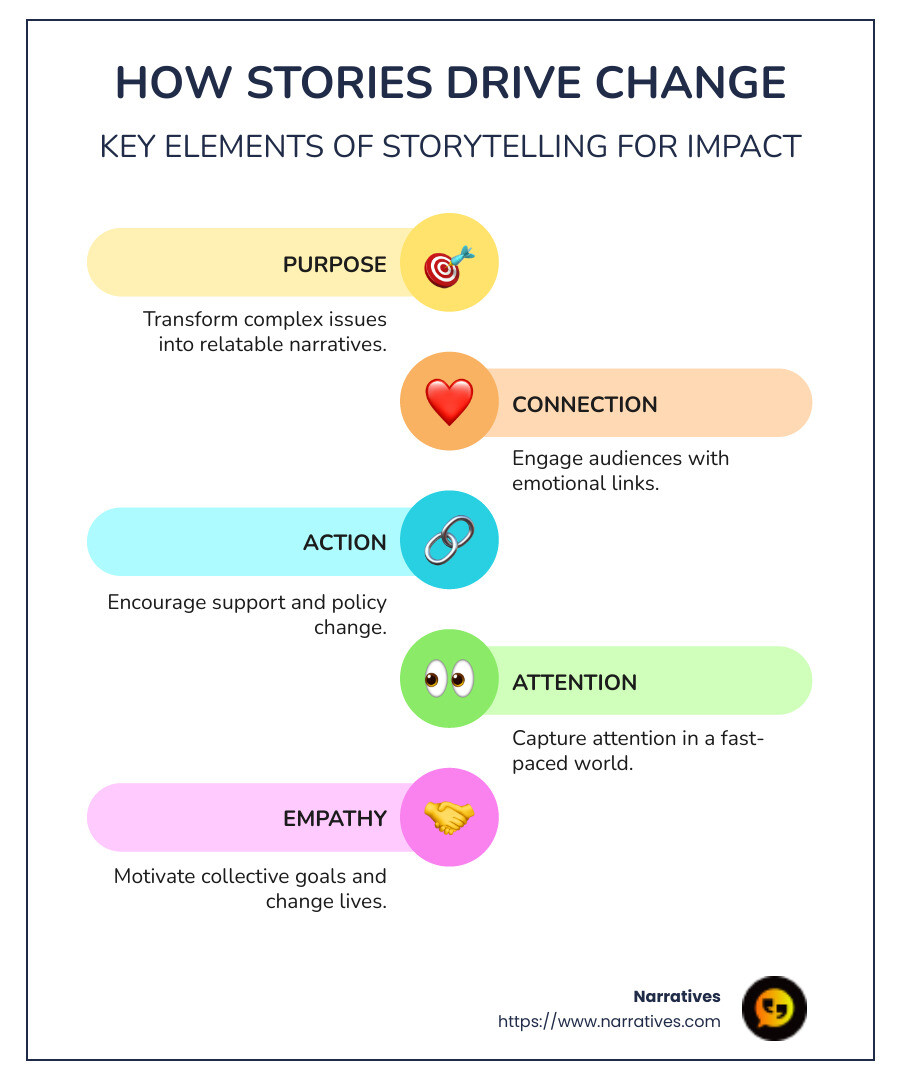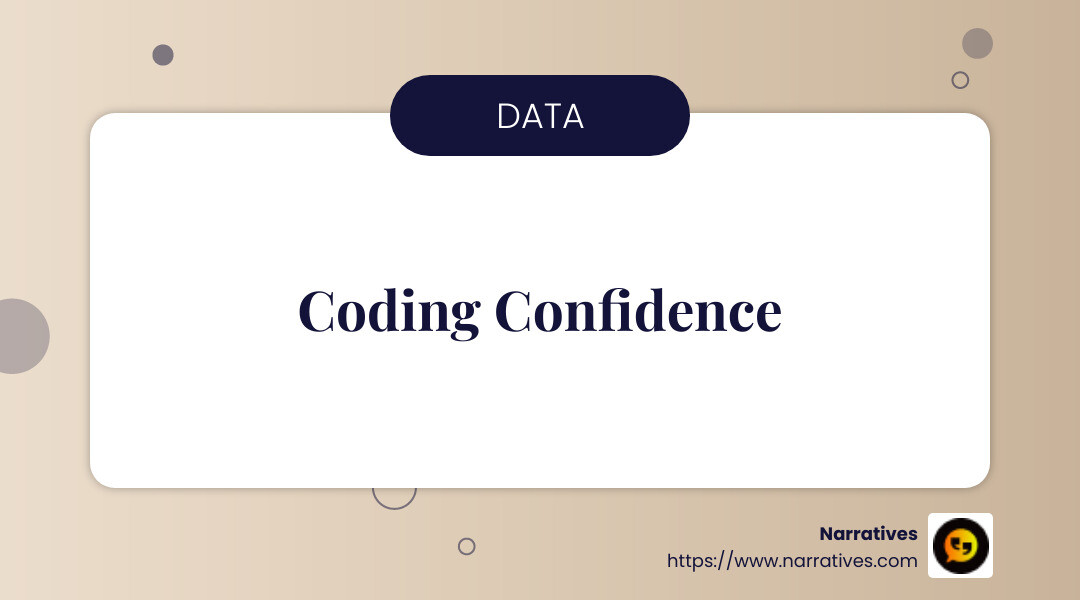From Words to Action: Mastering Storytelling for Impact

Storytelling for impact is a powerful tool that, when used effectively, can drive real change. Whether it's through personal anecdotes, visual storytelling, or engaging narratives, the ability to connect with an audience on an emotional level can inspire action and foster deeper understanding. Here's what you need to know:
- Purpose: Storytelling can transform complex issues into relatable narratives that highlight their significance.
- Connection: Engages audiences by creating an emotional link, making messages memorable and impactful.
- Action: Encourages support, whether that’s through donations, awareness, or policy change.
In today’s world, capturing attention is crucial, and storytelling has the unique ability to humanize even the most data-driven initiatives.
Stories can evoke emotions, spark empathy, and motivate people toward collective goals. This is the essence of storytelling for impact—turning words into actions that change lives.

The Power of Storytelling for Impact
The Science Behind Storytelling
Storytelling isn't just an art; it's a science. When we hear a story, our brains release chemicals like cortisol, dopamine, and oxytocin, which play a crucial role in how we process and react to narratives.
- Cortisol helps us focus by grabbing our attention, especially during tense or suspenseful moments in a story.
- Dopamine makes us feel good, enhancing our enjoyment and memory of the story. It's what keeps us engaged and eager to hear more.
- Oxytocin fosters empathy and connection, making us care about the characters and the outcomes of their stories.
This chemical cocktail is why stories can create strong emotional connections, which are essential for inspiring action and building trust. When people feel connected to a narrative, they're more likely to remember it and be motivated to act on it.
Storytelling in a Business Context
In the business world, storytelling is a powerful tool for engaging audiences and driving change. Here’s how it works:
Engage Audiences: A well-told story can captivate an audience, making complex data and dry facts come alive. When a business uses storytelling, it turns abstract concepts into relatable and memorable narratives.
Lift Morale: Sharing stories of success and overcoming challenges can boost morale within a company. It reminds employees of their shared mission and the impact of their work, fostering a sense of pride and belonging.
Drive Change: Stories can be catalysts for change, both internally and externally. Whether it's rallying a team around a new initiative or influencing public opinion, storytelling can propel organizations toward their goals.
By weaving narratives that resonate on a personal level, businesses can build trust with their audience. This trust is crucial for long-term relationships and sustained action, making storytelling an invaluable asset in any strategic communication plan.

Crafting Compelling Impact Stories
Creating a compelling impact story starts with a strong problem statement. This is the cornerstone of your narrative, providing clarity and focus on the core challenge your organization aims to address. A well-crafted problem statement is concise and meaningful, capturing the essence of the issue in a way that resonates with your audience.
For example, consider a program focused on young women in tech. A strong problem statement might read:
"Young women are underrepresented in the tech industry due to limited access to STEM education, role models, and mentorship opportunities, leading to a lack of gender diversity and innovation."
This statement clearly outlines the problem and sets the stage for the rest of the story.
Using a Theory of Change Framework
Once you have a strong problem statement, the next step is to develop a Theory of Change (ToC). This strategic framework illustrates how your activities will lead to desired outcomes and social impact.
Here's how to build a Theory of Change:
Identify Activities: Start by detailing the specific activities your organization will undertake to address the problem. For instance, offering coding workshops and mentorship opportunities for young women.
Define Outcomes: Next, outline the measurable outcomes you expect from these activities. In our example, this could be increased coding skills and readiness for STEM careers.
Articulate Social Impact: Finally, describe the broader social impact you aim to achieve. This might include greater gender diversity in the tech workforce and reduced gender pay gaps.
By using a Theory of Change, you can clearly demonstrate the logical flow from activities to outcomes to impact, making it easier for your audience to understand and support your mission.
Objectives of Storytelling for Impact
Your storytelling should also have clear objectives. These might include:
- Highlighting Social Issues: Frame complex social issues in a personal and relatable manner to inspire empathy and understanding.
- Influencing Public Perception: Use real-life examples to change negative stigmas and educate audiences.
- Driving Societal Change: Inspire action and motivate people to participate in collective efforts for change.
By aligning your story with these objectives, you ensure that it not only communicates your mission but also inspires action and builds trust.
Strategies for Effective Storytelling
Crafting stories that leave a lasting impact requires a blend of engagement, visualization, and consistency. These elements ensure your narrative not only reaches your audience but resonates deeply with them.
Balancing Quantitative and Qualitative Data
A powerful story combines both numbers and narratives. Quantitative data provides the hard evidence of success, while qualitative anecdotes add the emotional layer that makes the data come alive.
Metrics: Choose metrics that reflect real impact, not just participation numbers. For instance, instead of counting attendees, measure outcomes like "coding confidence" or "job placements" for a program like Girls Who Code.

Anecdotes and Testimonials: Personal stories and testimonials from participants highlight the human side of your impact. A young woman sharing how a bootcamp transformed her career prospects can be more compelling than any statistic.
By combining these elements, you create a narrative that is both credible and relatable, reinforcing your message with evidence and emotion.
Ethical Storytelling Practices
Ethical storytelling is about respecting the dignity and complexity of your subjects. Here are key practices to keep in mind:
Consent: Obtain informed consent from all story contributors. Ensure they understand how their stories will be shared and the purpose behind it. Consent is not just a formality; it’s about trust and transparency.
Multi-Dimensional Representation: Avoid one-dimensional portrayals. Present individuals as multi-faceted beings with strengths, achievements, and challenges. This approach combats stereotypes and offers a fuller picture of their experiences.
Do No Harm: Prioritize the well-being of your story subjects over advocacy goals. If sharing a story could cause harm, reconsider its necessity or find a way to mitigate potential risks.
By adhering to these ethical guidelines, you create stories that not only inform but also empower and respect those involved.
Consistency in Storytelling
Consistency ensures that your message remains clear and cohesive across different platforms and formats. Whether in web posts, social media, or video scripts, maintain a unified voice and style that reflects your organization's values and mission.
In conclusion, by balancing data with personal stories, adhering to ethical practices, and ensuring consistency, you can harness the power of storytelling for impact to inspire change and build trust with your audience.
Storytelling Formats and Techniques
Visual Storytelling
Visual storytelling is a powerful tool for creating impactful narratives. It uses images, videos, and infographics to convey messages quickly and effectively. Here's how you can use different formats to tell your story:
Photography: A single photo can speak volumes. Use images to capture the essence of your story and evoke emotions. For example, a photo of a child using a newly installed community internet hub can highlight the joy and potential of connectivity.
Infographics: These are perfect for presenting data in a visually appealing way. They help simplify complex information, making it accessible and engaging. An infographic showing the growth of internet access in rural areas can illustrate progress at a glance.
Videos: Videos combine visuals, audio, and narrative, making them incredibly engaging. A short video can showcase the journey of a community project, from inception to impact, bringing the story to life.
Storytelling for Social Impact
Storytelling can drive societal change by shifting public perception and fostering community-driven initiatives. Here's how:
Web Posts: Write compelling narratives that highlight the "why" and "what" of your project. Share stories of individuals or communities affected by your work. Use a catchy headline to draw readers in, like "Changing Lives: How Internet Access Changed a Village."
Social Media: Platforms like Twitter and Instagram are ideal for concise, impactful stories. Use powerful statistics or quotes from beneficiaries. Include relevant hashtags to expand your reach and engage with a broader audience. A tweet with a quote from a project participant can spark conversations and inspire action.
Video Scripts: Craft scripts that start with the "why," introduce the "who," and end with the positive change ("what"). Ensure good audio and video quality to maintain professionalism. A well-crafted script can turn a local initiative into a global inspiration.
By leveraging these formats, you can create stories that not only inform but also inspire action and foster a sense of community. In the next section, we'll explore how storytelling can challenge negative stigmas and influence public perception.
Frequently Asked Questions about Storytelling for Impact
How can storytelling change negative stigmas?
Storytelling is a powerful way to change negative stigmas by creating emotional connections and fostering empathy. When we hear stories of real people facing challenges, our perceptions can shift. For example, the #MeToo movement used personal stories to change how society views sexual harassment. By sharing experiences, storytelling can challenge stereotypes and humanize complex issues.
What are the key elements of a powerful impact story?
A powerful impact story has several key elements:
Authenticity: The story must feel real and sincere. Authentic storytelling, like the kind used in the documentary "13th," connects with audiences by sharing genuine experiences and emotions.
Compelling Characters: Strong characters help audiences relate on a personal level. Whether it's an individual or a community, characters like those in An Inconvenient Truth make the narrative more engaging.
Narrative Arc: A clear structure keeps the audience engaged. Start with a hook, build tension, and end with resolution. This arc helps maintain interest from beginning to end.
Call to Action: Encourage the audience to take action. A clear call to action, like signing a petition or donating, empowers people to contribute to change.
How does storytelling influence public perception?
Storytelling can greatly influence public perception by making issues more relatable and understandable. When stories are shared on social media or through videos, they reach a wide audience quickly. This can shift public opinion, as seen with movements like #BlackLivesMatter. By highlighting real-life experiences and outcomes, storytelling can drive societal change and encourage community involvement.
In the next section, we'll dig into Narratives' approach to non-profit partnerships and how community-driven storytelling can amplify voices and foster positive change.
Conclusion
At Narratives, we believe in the transformative power of storytelling to drive social impact. Our mission is to serve as the go-to digital storytelling partner for non-profits and purpose-driven organizations. By focusing on non-profit partnerships and community-driven storytelling, we aim to amplify underrepresented voices and inspire action.
Non-Profit Partnerships
Collaborating with non-profits allows us to create high-quality, emotionally resonant content that highlights their work and impact. Through storytelling, non-profits can build trust with their audience and increase visibility for their causes. By sharing genuine stories of change, we help these organizations connect with supporters on a deeper level.
Community-Driven Storytelling
Community-driven storytelling is at the heart of our strategy. We work closely with the communities we feature, ensuring their stories are told authentically and ethically. By involving community members as co-creators, we ensure that the narratives are not only accurate but also empowering. This approach fosters a sense of ownership and pride, encouraging communities to engage actively in the storytelling process.
Our commitment to ethical storytelling practices ensures that all voices are respected and heard. We prioritize consent, multi-dimensional representation, and the principle of "do no harm" in every story we craft.
By leveraging the power of storytelling for impact, we strive to change perceptions and inspire positive societal change. Our work is a testament to the belief that stories can indeed shape a more just and compassionate world.
For more on how Narratives can partner with your organization to create impactful stories, learn more here.


